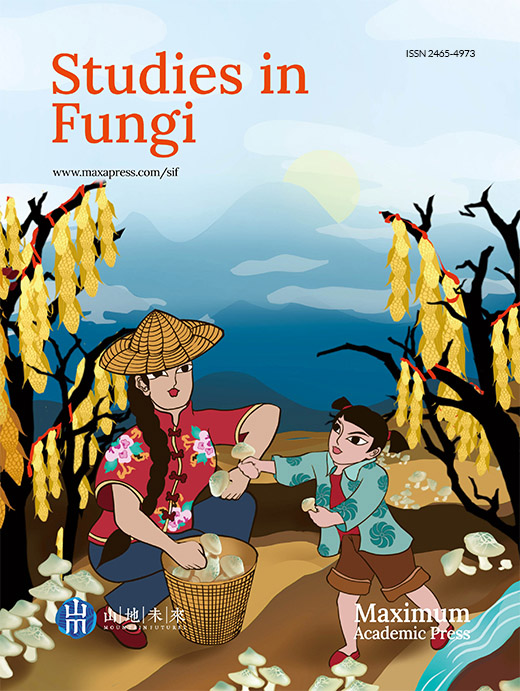HTML
-
Wild mushrooms have been consumed since ancient times due to their good taste and nutritional values. Also, mushrooms have the advantage of being rich in vital components such as proteins, vitamins, chitin, fibers, iron, zinc, selenium, sodium, etc. (Breene 1990, Chang & Miles 1992, Elkhateeb et al. 2019, 2020a, b, Daba et al. 2020, El-Hagrassi et al. 2020). Beside these nutritional values, many mushrooms have gained importance due to their therapeutical potentials (Bobek et al. 1995, Bobek & Galbavý 1999, Vaz et al. 2011, Khatun et al. 2012, Elkhateeb & Daba 2020, 2021a, b). The extracts of fruit bodies and mycelium obtained from various fungi have shown a crucial role in the prevention and/or the treatment of many diseases (Wasser & Weis 1999, Sharma et al. 2015). Nowadays, some immunomodulating molecules that have been obtained from different medicinal mushrooms have found great importance in improving the immune function in cancer patients while they are receiving chemo or radiotherapy (Mizuno 1995). Other edible mushrooms have gained medicinal importance due to their effectiveness in adjusting the blood pressure and reducing the free plasma cholesterol, as well as due to antimicrobial, antioxidant, and antitumor properties (Kabir & Kimura 1989, Smânia et al. 1995, Mau et al. 2005, Elkhateeb 2020, Thomas et al. 2020). The genus Ramaria is found all over the world, in which various species of Ramaria have been consumed by people for nutritional purposes. However, more studies are required to be conducted on these genera in order to detect the nutraceutical and nutritional compounds of these mushrooms. The genus Ramaria belonging to Basidiomycota, Class; Agaricomycetes, Order; Gomphales, Family; Gomphaceae, which includes approximately 200 species of coral fungi (Sharma et al. 2015). Several taxa are edible and picked in Europe and also they are easily confused with several mildly poisonous species capable of causing nausea, vomiting and diarrhea, in which among the most unusually shaped mushrooms of all, Ramaria are appropriately referred to as the coral mushrooms. Ramaria are recognizable by their variably thickly branched fruit bodies, fleshy and tough textures sometimes partly gelatinous or jellylike. Although many Ramaria species are very brightly colored, just as many are dull, and all have a tendency to become rather drab in age. Similar genera include Phaeoclavulina, Lentaria, Artomyces, and Ramariopsis, which differ in various aspects of color, consistency, substrate, microscopic features, or ecology (Sharma & Gautam 2017).
Ramaria basidiocarps are either lignicolous or terricolous (white, yellow, orange, red, brilliant purple, brown and sometimes green hues) with many species forming a characteristic mycelial mat in the soil beneath the sporocarps (Nouhra et al. 2004). The colour may fade or change after collection in the field. Species of this genus often show a color change on bruising. The flesh may change to green (virescent), red brown (rubribrunnescent), brown to yellow brown (brunnescent), or a red wine color (vinescent) due to age or environmental conditions (Exeter et al. 2006).
Clavaria is belonging to Basidiomycota, class Agaricomycetes, order Agaricales, and family Clavariaceae. Species of Clavaria produce basidiocarps (fruitbodies) that are cylindrical to club-shaped, branched and coral-like. They are often grouped with similar looking species from other genera, and they are collectively known as the clavarioid fungi (Olariaga et al. 2015).
The most common species of this genus is Ramaria stricta (Kuo 2009), which grows on wood debris, which features branches that are usually strictly oriented, so that they are mostly straight and ascending. When fresh, its branch tips are yellow and its branches are dull yellowish buff, but its surfaces bruise and discolor purplish brown. Under the microscope it features roughened spores, clamp connections, and thick-walled hyphae. Several very similar species have been separated by mycologists, and the name Ramaria stricta should probably represent a group of potential species awaiting contemporary study. Ecology: Uncertain; while most ramarias are thought to be mycorrhizal, the wood-inhabiting species could be mycorrhizal or saprobic; growing from the dead (but sometimes buried) wood of conifers; appearing alone, scattered, or gregariously; early summer through fall; apparently widely distributed in North America, but more common from the Rocky Mountains westward. Fruitbody: 4−14 cm high; 4−10 cm wide; base well developed or nearly absent; branching repeatedly. Branches: Vertically oriented and elongated; often flattened; smooth; yellowish buff, becoming orangish buff as the spores mature; bruising and discoloring purplish brown; tips yellow when fresh and young. Base: Nearly absent, or fairly well developed; to 2 cm wide; white below; colored like the branches above; attached to numerous white rhizomorphs. Flesh: Whitish; fairly tough. Odor and Taste: Odor not distinctive, or sweet and fragrant; taste bitter. Spore color: Rusty yellowish. Microscopic Features: Spores are yellow-brown to rusty-brown in mass deposit 7.5−10.5 × 3.5−5µm; stretched-elliptical; smooth to roughened. Clamp connections present. Thick-walled hyphae present (Kuo 2009) (Figs 1, 2).
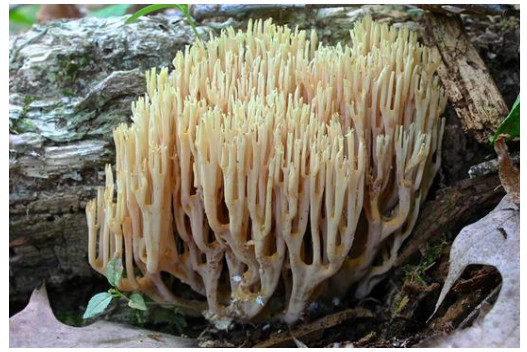
Figure 1. Fruitbody of Ramaria stricta in the field. The photograph was taken at the Sewickley Heights Borough Park, PA, USA by Fluffberger (https://www.inaturalist.org/observations/3596638). The photo was used under the CC BY-NC 4.0 non-commercial use license. Scale bar = 10 cm.
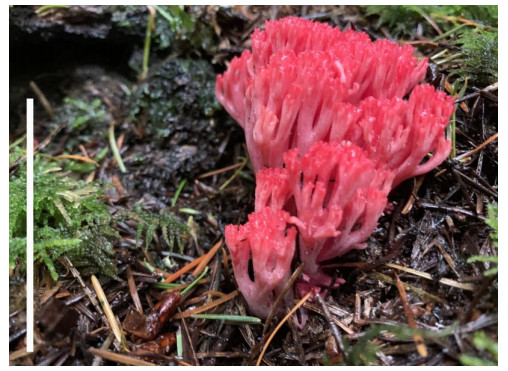
Figure 2. Fruitbody of Ramaria araiospora in the field. The photograph was taken at the Millersylvania State Park, Olympia, WA, USA by Yay4john (https://www.inaturalist.org/observations/62355314). The photo was used under the CC BY-NC 4.0 non-commercial use license. Scale bar = 10 cm.
Few reports have been found about the discovery of these genera in the Northwestern Himalayas. The current surveys to Northwestern Himalayas have shown the existence of six species of coral mushrooms belonging to the genus Ramaria viz., R. aurea, R. botrytis, R. flava, R. flavescens, R. rubripermanens, and R. stricta (Sharma & Gautam 2017). Details about their culinary status were obtained from native inhabitants. Moreover, studies have been conducted on these species to get detailed biochemical profiling as well as exploring their various biological activities (Sharma & Gautam 2017).
-
Coral mushrooms gain great therapeutical and nutritional importance due to their valuable components. Sharma & Gautam (2017), reported that 12 edible species of Ramaria occurring in Northwestern Himalayas contain proximal components, amino acids, and minerals, fatty acids. Ramaria aurea is an edible mushroom that is considered a promising dietary supplement as it consists of carbohydrates, amino acids, proteins, fibers, and minerals (Rai et al. 2013). Ramaria botrytis, another edible mushroom, consists of unsaturated fatty acids, tocopherol as well as other bioactive compounds (e.g. ascorbic acid, carotene, flavonoids, β- and lycopene) (Barros et al. 2008). Ramaria subalpina also contains significant amounts of ascorbic acid, β-carotene, flavonoids, and lycopene (Acharya et al. 2017). Also, some Ramaria species show the presence of alkaloids, saponins, terpenoids, coumarins, and cardiac glycosides (Aldred 2008, Dattaraj et al. 2020). Due to the existence of these bioactive molecules, these mushrooms possess various medicinal importance against various diseases. Among these medicinal benefits are antimicrobial, antiviral, anti-parasitic, antioxidant, radical scavenger, anticancer, anti-inflammatory, immune system enhancer, and anti-hyperlipidemia (Wasser 2017).
-
Although there is a vast diversity of synthetic antibacterial compounds, the development of bacterial resistance has been substantially increasing (Alves et al. 2012). Thus, discovering novel antibiotics especially from natural sources is urgently required. Since ancient times, several natural resources have exerted potent antimicrobial activities. Among these natural resources are mushrooms that might be valuable alternative sources of novel antimicrobials (Gebreyohannes et al. 2019, Ghosh et al. 2020). In this context, various Ramaria sp. have gained great importance due to their potential antimicrobial activities against various pathogens (Table 1). The ethanolic extract of Ramaria flava was detected by the agar-well diffusion method, and the result showed positive activity against some Gram-positive bacteria such as Staphylococcus aureus ATCC 25923, Staphylococcus aureus Cowan I, Micrococcus luteus NRRL B-4375, Micrococcus flavus, Bacillus subtilis ATCC 6633, Bacillus cereus RSKK 863. Also, R. flava ethanolic extract showed potent activity against the tested Gram-negative bacteria including Salmonella enteritidis RSKK 171, Yersinia enterecolitica RSKK 1501, Klebsiella pneumoniae ATCC 27736 (Gezer et al. 2006). Additionally, Ramaria cystidiophora showed antimicrobial activity against Mycobacterium smegmatis (MIC = 8 µg/mL), and against Mycobacterium tuberculosis (MIC 64−128 µg/mL) (Hassan et al. 2019).
Table 1. Antimicrobial activities of various Ramaria species
Ramaria species Tested extract Employed methods Tested bacteria Tested fungi References Gram-positive Gram-negative R. formosa Ethyl acetate, methanol, and water Percentage of inhibition B. subtili, S. aureus E. coli, K. pneumonia, Proteus vulgaris, P. aeruginosa Not tested Pala et al. 2019 R. formosa Methanol Inhibition zone assay S. aureus P. aeruginosa Candida albicans Ramesh & Pattar 2010 R. zippellii Ethanol, water 96-well microplate bioassay S. aureus E. coli No activity Bala et al. 2011 R. aurea Ethanol Inhibition zone assay S. aureus E. coli, P. aeruginosa, P. vulgari Candida albicans Rai et al. 2013 R. flava Ethanol Inhibition zone assay B. subtili, S. aureus E. coli Fusarium auenaceum, F. graminearum and Cercosporella albomaculans Liu et al. 2013 R. flava Ethanol Agar-well diffusion method S. aureus, Micrococcus luteus, M. flavus, B. subtilis, B. cereus Salmonella enteritidis, Yersinia enterecolitica and K. pneumoniae No activity Gezer et al. 2006 R. botrytis Ethanol Methanol Acetone Ethyl acetate Inhibition zone diameter S. aureus P. aeruginosa, E. coli, Enterobacter cloacae No activity Han et al. 2016 The studies also reported that the ethanolic extract of Ramaria flava exhibited antifungal activities against three pathogenic fungi which are C. albomaculans, Fusarium graminearum and Fusarium auenaceum. The extract showed the highest efficacy against F. auenaceum, where 36.64% reduction in fungal growth was observed at the concentration of 2 mg/mL. The extract also inhibited the growth of F. graminearum and C. albomaculans by 19.99 and 30.03% respectively, at the same concentration of 2 mg/mL (Liu et al. 2013). Additionally, Ramaria mushrooms show their effectiveness to cure various viral infections. Zhang et al. (2015) isolated a novel ribonuclease from Ramaria formosa fruiting bodies and tested its antiviral activity against HIV-1 reverse transcriptase enzyme. The results showed that the ribonuclease showed 93% inhibition at a concentration of 30 µM (maximum tested concentration) and with an IC50 value of 3 µM. It was interesting to report that this enzyme exhibits unique features; these include its unique N-terminal sequences, optimum acidic pH value, and temperature resistance. Taken together these features suggest that this ribonuclease could play a vital role in HIV diseases prevention.
Antioxidant activity
-
Many reports regarding the antioxidative properties of various Ramaria sp. have been published, which showed the activity of these fungi as effective antioxidants (Table 2). Linoleic acid oxidation was compared with those of α- tocopherol, BHA, and R. flava ethanol extract. The results revealed that the inhibition values of both the standards and R. flava ethanol extract increased gradually with increasing the concentrations. 80 µg/ml BHA, α -tocopherol, and R. flava ethanolic extract exhibited 96.4, 98.6, and 73.3% inhibition, respectively. Whereas increasing the concentrations to 160 µg/ml concentrations resulted in 98.9, 99.2 and 94.7% inhibition, respectively (Gezer et al. 2006). Also, the ethanolic extract of that mushroom exhibited promising OH and DPPH radical-scavenging activities with low IC50 values of 18.08 and 5.86 μg/mL, respectively (Liu et al. 2013). The high inhibition value of R. flava ethanolic extract could be related to the high concentration of phenolic compounds (Komali et al. 1999).
Table 2. Antioxidant activities of various Ramaria species isolated from different places
Ramaria species Place of collection Methods used Activity (EC 50 % of inhibition) References R. flava Turkey DPPH scavenging assay 94.78% at 12 mg/mL Gursoy et al. 2010 β-carotene linoleic acid assay 95.02% at 20 mg/mL Reducing power 95.02% at 20 mg/mL Metal chelating effect 96.75 at 2 mg/mL R. flava Turkey DPPH scavenging assay 276 µg/mL Gezer et al. 2006 β-carotene linoleic acid assay 94.7% at 160 µg/mL R. formosa India DPPH radical scavenging activity 5.8 mg/ml Ramesh & Pattar 2010 R. patagonica Argentina DPPH scavenging assay 770 µg/mL Toledo et al. 2016 β-carotene linoleic acid assay 610 µg/mL Reducing power 170 µg/mL TBARS inhibition activity 60 µg/mL R. Formosa Korea DPPH scavenging assay 117 AsA/mg/mL at 500 µg/mL Kim et al. 2016 Reducing power 36% copper ion inhibition at 20 µg/mL concentration Peroxyl radical scavenging activity 7.8 µM trolox equivalent at 20 µg/mL R. stricta Ukraine Total antioxidant status 4.223±0.054 mmol/l Krupodorova & Sevindik 2020 Oxidative stress index 0.194±0.001 Total oxidant status 8.201 ± 0.095 μmol/l ABTS assay is another assay employed to evaluate the free radical scavenging ability resulted from hydrogen-donating ability (Re et al. 1999). A study reported that R. largentii extract was able to scavenge ABTS radical cation in a concentration-dependent manner. At an extract concentration of 250 mg/mL the scavenging activity was recorded to be 93.53 ± 0.03% (Aprotosoaie et al. 2017). A polyphenol-rich extract of R. aurea exhibited superoxide and DPPH radicals scavenging ability with EC50 of about 0.283 and 0.384 mg/mL, respectively (Khatua et al. 2015). Thus, Ramaria species extract seems to be a reasonably free radical scavenger agent.
Anticancer activity
-
Cancer is one of the main causes of death worldwide. Thus, finding new molecules to prevent and/or treat cancer, especially from natural sources with lower toxicity, is considered a goal for scientists nowadays (Wang et al. 2012). As mentioned previously, mushrooms are sources of powerful pharmaceutical products. About 651 higher basidiomycetes species exhibit antitumor activities (Fan et al. 2006). In general, fungal anticancer substances are divided into two main groups which are low and high molecular-weight compounds. The low-molecular-weight secondary compounds comprise mainly sesquiterpenes, steroids and sterols, triterpenes, and polyketides (Mahajna et al. 2008). These molecules can penetrate the cell membrane and work on the targeted signal-transduction pathways (Zaidman et al. 2005). However, the high-molecular-weight compounds include polysaccharides or protein-bound polysaccharides (Kidd 2000). In 1982, a study reported by Yoo et al. (1982), examined the antitumor activity of a high molecular weight protein-bound polysaccharide fraction obtained from Ramaria formosa. These molecules were able to inhibit 66% of a tumor when administered at the dosage of 50 mg/kg/day and the tumor was wholly degenerated in two out of eight mice.
The growth inhibitory effect of the ethanol extract obtained from Ramaria flava was tested on human cancer cell lines (BGC-803, NCI-H520, and MDA-MB-231) and the results showed a promising inhibition activity on the three human cancer cells with inhibition percentages of 33.83%, 54.63%, and 71.66% respectively, at mushroom extract concentration of 200 µg/mL. A major antitumor sterol found in many edible mushrooms is ergosterol peroxide is (Lindequist et al. 2005). Previous studies reported the antitumor properties of ergosterol peroxide in various cancer cells including SCC4 (head and neck squamous cell carcinoma), U266 (multiple myeloma), DU145 (prostate cancer), as well as MDA-MB-231 (breast cancer) cells (Rhee et al. 2012). Ergosterol peroxide inhibited cell growth and induced apoptosis in human prostate cancer cells DU-145 and LNCaP (Russo et al. 2010). Moreover, ergosterol peroxide showed a cytotoxic effect against Hep 3B cells (Chen et al. 2009). Six sterols comprising ergosterol peroxide were isolated from R. flava (Liu et al. 2012). And interestingly, their ethanolic extract exerted promising growth inhibitory activity on MDA-MB-231(human breast cancer cell line) which suggests that R. flava could find a great application as an antitumor agent.
Other biological activities of Ramaria species
-
To date, a few numbers of other biological activities have been determined in Ramaria species. In a previous study, the hepatoprotective activity of methanol extract of R. botrytis towards liver toxicity induced by benzo(α)pyrene in mice was evaluated (Kim & Lee 2003). The results reported that the methanolic extract significantly reduced the elevated enzyme activities including glutathione S-transferase and r-glutamylcysteine synthetase that resulted from the induction of benzo(α)pyrene. The hepatoprotective activity of this mushroom could be related to its high antioxidant potential which was revealed by the low EC50 value (0.109 mg/ml) for DPPH radical scavenging assay. Ramaria botrytis collected from hilly areas of Darjeeling exerted potential immunostimulatory effect in a murine macrophage cell line (RAW264.7 cell) as well as in thymocyte cells and splenocytes. This activity was related to a water-soluble glucan obtained from fresh fruiting bodies of such mushrooms and which consisted of (1→6)-linked-β-D glucopyranosyl residues with the branching of (1→3)-linked-β-D-glucopyranosyl at O-3 position. This glucan enhanced the nitric oxide level and also resulted in the stimulation of thymocyte and splenocyte proliferation rates. Thus, this glucan can be employed as a potent immunostimulatory (Bhanja et al. 2013).
Ramarin A and B are two novel sesquiterpene derivatives that were obtained and purified from the methanol extract of Ramaria formosa that is a very rare mushroom and that inhibits human neutrophil elastase, and thus can be employed for the treatment of skin aging (Kim et al. 2016). A recent study reported by Bhanja et al. (2020), prepared bio metallic composite nanoparticles from polysaccharides isolated from Ramaria botrytis. The nanoparticles exerted antibacterial activity against Pseudomonas aeruginosa. Moreover, these nanoparticles showed potential antioxidant activities towards DPPH radical, hydrogen peroxide, and nitric oxide radicals. They also catalyzed the p-nitrophenol reduction, indicating a new direction in the field of biomedicine mediated by nanotechnology (Bhanja et al. 2020).
Clavaria sp.
-
All Clavaria species are terrestrial and most are believed to be saprotrophic (Decaying dead plant material). In North America and elsewhere, they are more commonly found in woodlands. Clavaria fruit bodies are simple (cylindrical to club-shaped) or more rarely branched, sometimes with a distinct stem. Several of the species with simple fruit bodies form them in dense clusters. The fruit bodies themselves are smooth to grooved and typically brittle. Depending on species, they vary in color from white or cream to yellow, pink, violet, brown, or black. The hyphal system of Clavaria species is always monomitic. The context hyphae are inflated, thin-walled, and lack clamp connections (Olariaga et al. 2015). The basidia are two to four spored, in some species with an open, loop-like clamp connection at the base. Spores are smooth or spiny and color is white. Most Clavaria species are thought to be saprotrophic, decomposing leaf litter and other organic materials on the woodland floor. In Europe, species are more frequently found in old, unimproved grasslands, where they are presumed to be decomposers of dead grass and moss. Species of Clavaria occur in suitable habitats throughout the temperate regions and the tropics (Figs 3, 4) (Acharya 2012, Kautmanová et al. 2012).
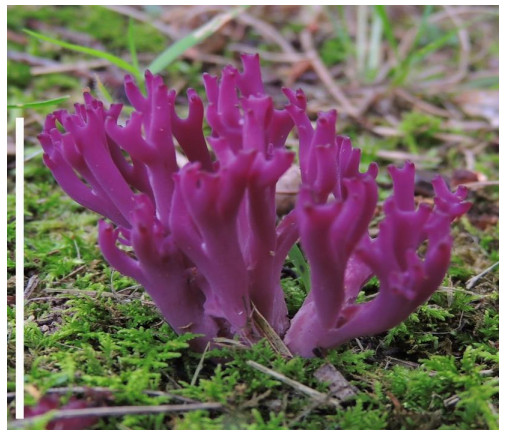
Figure 3. Fruitbody of Clavaria zollingeri in the field. The photograph was taken at Ohio, USA by Rcurtis (https://www.inaturalist.org/observations/1693040). The photo was used under the CC BY-NC 4.0 non-commercial use license. Scale bar = 10 cm.
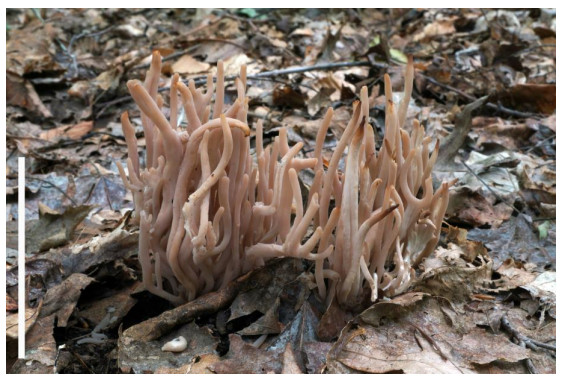
Figure 4. Fruitbodies of Clavaria rubicundula in the field. The photograph was taken at Hewitt, West Milford, NJ 07421, USA by Tombigelow (https://www.inaturalist.org/observations/16044756). The photo was used under the CC BY-NC 4.0 non-commercial use license. Scale bar = 10 cm.
Clavaria sp. biological activities
-
Ramaria and Clavaria are the two major genera of coral mushrooms within families Gomphaceae and Clavariaceae, respectively. Besides having important role in forest ecology, some species of these are reported to possess high nutraceutical and bioactive potential (Sharma & Gautam 2017). Many current studies describe the detailed biochemical profiling and antioxidant, and antibacterial activities of twelve coral mushroom (Ramaria and Clavaria) species (Vidović et al. 2014). Antioxidant activities were calculated using EC50 values from mushroom extracts. Antibacterial activities were checked on six pathogenic bacterial strains through minimum inhibition concentrations. All the species were found to be rich in protein, macro and micro minerals, carbohydrates, unsaturated fatty acids, essential amino acids, phenolics, tocopherols, anthocynadins and carotenoids. All the species showed significant antioxidant and antibacterial activities. These species are reported to free from heavy toxic metals. Sharma & Gautam (2017), reported that these Ramaria and Clavaria species will open the way for their large-scale commercial exploitations and use in pharmaceutical industries as antioxidant, antibacterial and nutraceutical constituents.
Antimicrobial activity
-
Many studies conducted on Ramaria and Clavaria species are represented in the current review and showed that coral mushrooms exhibit the potential as a vital therapeutic food. However, more studies for profound exploration are still required. Ramaria and Clavaria species exerted some vital biological activities such as antimicrobial, antioxidant, antitumor, hepatoprotective, and anti-skin aging activity, etc. Further investigation is needed to explain the different mechanisms of action of these wild mushrooms. Although the nutritional values of the genus Ramaria and Clavaria have been also studied, there is a lack of information about their bioavailability, vitamin and mineral, and compositions. Thus, the current review recommends further exploration to get a full profile of the active components obtained from various Ramaria species and Clavaria species in nutrition and mycomedicine fields.
-
This research does not receive any external funding.
-
The authors declare no conflict of interest.
- Copyright: © 2021 by the author(s). This article is an open access article distributed under Creative Commons Attribution License (CC BY 4.0), visit https://creativecommons.org/licenses/by/4.0/.
| W Elkhateeb, M Elnahas, L Wenhua, MCA Galappaththi, GM Daba. 2021. The coral mushrooms Ramaria and Clavaria. Studies in Fungi 6(1):495−506 doi: 10.5943/sif/6/1/39 |


